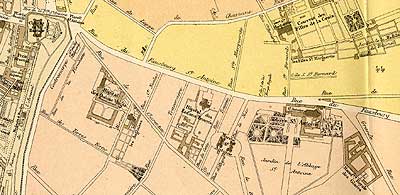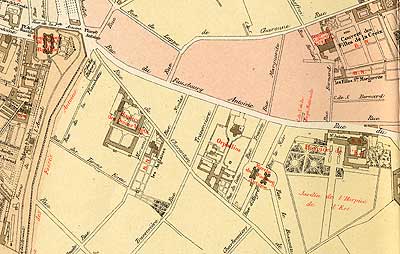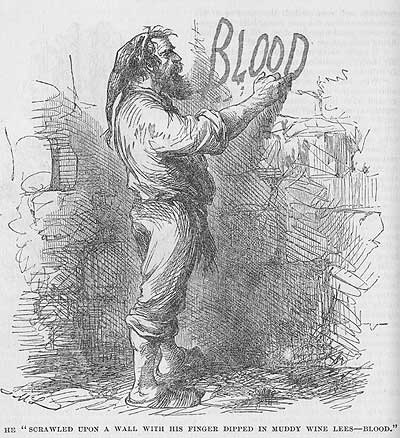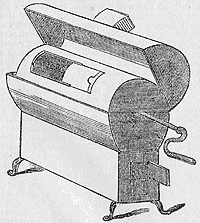|

NOTES ON ISSUE 2: GLOSSARY
PART 1 OF 3
Printable View
A large cask of wine had been
dropped and broken, in the street…, the hoops had burst, and it lay on
the stones just outside the door of the wine-shop, shattered like a
walnut-shell.
A cask is a barrel “formed of curved staves bound together by hoops,
with flat ends or ‘heads’” (Oxford
English Dictionary), and like a walnut because it is round and
wooden. The Dictionary of Daily Wants
(1859) describes a cask as follows, and gives us this illustration of a
cask in a cask-stand:

CASK. – A vessel of capacity for
containing beer, wine, and other liquids. The care and management of
casks is an important affair in a large establishment. It is found that
they last longest when stored either in a dry situation, or in one
uniformly very moist. Continual variations from one atmosphere to
another speedily rot casks. As soon as casks are emptied they should be
bunged down quite air-tight, with as much care as if they were full, by
which means they will be preserved both sweet and sound. Should any of
the hoops become loose, they should be immediately driven up tight,
which will at once prevent the liability of their being lost or
misplaced, as well as the casks becoming foul or musty from the
admission of air. For this purpose those out of use should be
occasionally examined. To sweeten casks when musty, it is best to
unhead them and wash them with quick-lime, or they may be washed with
oil of vitriol diluted with an equal weight of water. When casks are
very foul and resist these remedies they should be charred; a simple
and effectual method of performing this, is to wash the dry casks out
with the strongest oil of vitriol. In all cases the greatest care must
be taken to scald or soak, and well rinse out the casks after
subjecting them to this purifying process. (248)
The rough, irregular stones of the
street, pointing every way, and designed, one might have thought,
expressly to lame all living creatures that approached them, had dammed
it into little pools.
The streets were first paved in Paris beginning in 1450 (Baillie and
Salmon 119), but even-surfaced modern paving like macadam was not
invented until the 1820s (OED).
In 1775 (the year in which this portion of A Tale of Two Cities is set), as in
Dickens’ time, roads were paved with stones. A description in the Dictionary of Daily Wants (1859)
offers some idea of the difficulty of laying smooth roads:
PAVING. – In preparing for laying
down pavements, the first thing to be attended to is the foundation.
This must be made of strong and uniform materials, well rammed
together, and accurately formed, to correspond with the figure of the
superincumbent pavement. The kinds of stone used in paving are chiefly
granite, whinstone or trap, Guernsey or other pebbles, or water-worn
granite or trapstones. The size of the stones used in road paving is
commonly from five to seven inches long, from four to six inches broad,
and from six to eight inches deep. In laying down stones, each stone
should lean broadly and fairly on its base; and the whole should be
rammed repeatedly to make the joints close; the upper and lower sides
of the stones should be as near each other as possible, but they should
not touch each other laterally except near the top and bottom, leaving
a hollow in the middle of their depth to receive gravel, which will
serve to hold them together. This method of paving may be easily
executed by common workmen, who may throw in gravel between the stones
as they are laid down. It will be useful to cover newly-laid pavement
and gravel, which will preserve the fresh pavement for some time from
the irregular pressure of wheels till the whole is consolidated. The
stones should be of equal hardness, or the soft ones will be worn down
into hollows. In every species of paving, no stones should be left
higher or lower than the rest; for a wheel descending from a higher
stone will, by repeated blows, sink or break the lower stone upon which
it falls. (761)
Without proper maintenance, the paved
roads of districts like the one described by Dickens would quickly
become irregular and would be likely enough, as he says, to “lame all
living creatures.”
…the sodden and lee-dyed pieces of the cask…
The “lee” is “[t]he sediment deposited in the containing vessel from
wine and some other liquids” (OED).
The word is often used figuratively (in phrases like “to the lees”) to
mean “to the very end,” because the sediment of wine, being heavier,
tends to remain at the bottom of the cask or bottle. Casks would become
“lee-dyed” from this residue.
There was no drainage to carry off the wine…
Paris sanitation was more or less non-existent until the 14th
century, when King Phillipe Augustus began to take steps to
sanitize the city. One of his major contributions was to have
the roads paved, in order to reduce the smell of waste thrown
into the street (which became malodorous as it was assimilated
with the mud). In response to plagues in the 16th century, cesspools
for the collection of wastes were mandated under each city dwelling
– but water-tightness was not required until the 19th.
In the 18th century, cesspools and
kennels – drains in the middle of street – were the primary means of
dealing with wastes in Paris. However, the most usual method for
disposing of garbage was “tout-a-la-rue” – “all in the street.” The
practice of chucking household garbage out the window had existed since
the period of the earliest attempts at sanitation in Paris, but
persisted into the 19th century, and was certainly the mode at the
period in which A Tale of Two Cities
is set: In 1780, an ordinance “once again forbade people from throwing
water, urine, feces or household garbage out the window” (Krupa, Paris: Urban Sanitation), and
Dickens himself describes how “…the room or rooms within every door
that opened on the general staircase [in the Saint-Antoine dwelling]
left its own heap of refuse on its own landing, besides flinging other
refuse from its own windows.” Thus, not only would there be “no
drainage to carry off the wine” spilled in the Paris street Dickens
describes, but drinking wine that had fallen on the paving stones could
seriously compromise one’s health.
The wine was red wine, and had stained the ground of the
narrow street in the suburb of Saint Antoine, in Paris, where it was
spilled.
The Parisian suburb of Saint Antoine, located east of the (then-standing)
Bastille, and oriented around the Faubourg Saint Antoine, became
part of Paris in 1702 (Maxwell 446). Now part of the Eleventh
Arrondissement [there are twenty arrondissements – postal
districts – in Paris (Baillie and Salmon 54)], it was,
in the 18th century and Dickens’ own time, a poor manufacturing
district; it is still, as contemporary guidebooks point out,
“working class … and a little scruffy” (Baillie
and Salmon 55).
Ever since the French Revolution, Saint
Antoine has been known for its revolutionary fervor, having played a
prominent part in the uprisings of 1789, 1841, and 1851 (Sanders 43-4).
The district was named after the Abbaye de Saint-Antoine-des-Champs, an
abbey built at the end of the 12th century on the site of a chapel
dedicated to Saint Anthony (Saint Antoine is the French version of Saint Anthony) (Berman 121-50). The Abbey is still visible on maps of Paris
up to 1789, but – with the confiscation of ecclesiastical property
during the Revolution – it became a Hospice.
The Abbaye St. Antoine, afterwards the Hospice de l’Est, is visible on
the Plan de la Ville de Paris en 1789
and the Plan de la Ville de Paris, Période Révolutionnaire, 1790-1794.
The portions of these maps given below – mapping the area between the
Place de la Bastille and the Abbaye/Hospice, in eastern Paris – show
the abbey/hospice at the far right.

Click on map for larger view

Click
on map for larger view
…many naked feet, and many wooden
shoes…
The wooden shoes of the French workers were called “sabots.” Carlyle
frequently refers to the “sabots” of the French peasants in The French Revolution, and the OED describes them as “wooden
shoe[s] made of a single piece of wood shaped and hollowed out to fit
the foot” or “[a] kind of shoe having a thick wooden sole and ‘uppers’
of coarse leather.” It is interesting to note that the word “sabotage”
– which seems to have come into English usage in the 20th century –
derives from the rebellious use to which the laboring classes put their
sabots. The OED gives the
following derivation from the French word “saboter” – “to make a noise
with sabots, to perform or execute badly, e.g. to ‘murder’ (a piece of
music), to destroy willfully (tools, machinery, etc.).” Sabots, in
short, have become symbolic of working-class rebellion and revolution.
...stave of the cask...
Staves are “narrow, shaped pieces of wood which, when placed together
side by side and hooped, collectively form the side of a cask, tub or
similar vessel” (OED).
…scrawled upon the wall with his finger dipped in muddy
wine lees – BLOOD.

Since this portion of the novel occurs
in France, the word scrawled upon the wall – though by
novelistic convention given by Dickens in English (“BLOOD”)
– would be the word SANG (French for “blood”).
The illustration of this scene in the American edition of 1859
(Peterson’s Uniform Edition of A Tale of Two Cities) extends the convention
to the visual register as well, and has the Frenchman writing
in English upon the wall of Saint Antoine.
And
now that the cloud settled on Saint Antoine, which a momentary gleam
had driven from his sacred countenance, the darkness of it was heavy –
cold, dirt, ignorance, want…
Dickens’ personification of Saint Antoine – his
tendency to refer to the district as though it were a single
person – is continued throughout the novel. The “sacred
countenance” of the Saint Antoine described here is of
course the metaphorical “countenance” or “face”
of the neighborhood – its streets, its denizens, and so
forth. However, the original “sacred countenance”
of Saint Antoine belonged to Saint Anthony, for whom the district
was – indirectly – named.
The Saint Antoine district was named
after the Abbaye de Saint-Antoine-des-Champs (the “Abbey of St. Anthony
of the Fields”), which was founded in the last decade of the 12th
century on the site of a chapel already dedicated to Saint Anthony
(Berman 121-56). Though there have been a number of saints named
Anthony, the saint to whom the abbey and its predecessor were dedicated
is probably the Saint Anthony known as the “patriarch of monks,” or
“Saint Anthony of the Desert,” born in Egypt in 251 A.D. According to
the notation on his Saint’s Day in the Book of Days (1864), he is “one of
the most notable saints in the Romish [i.e. Catholic] calendar” (124,
vol. 1) and
The Temptations of St. Anthony
have, through St. Athanasius’s memoir, become of the most familiar of
European ideas. Scores of artists from Salvator Rosa [a famous
picturesque painter of the 17th century] downwards, have exerted their
talents in depicting these mystic occurrences. Satan, we are informed,
first tried, by bemudding his [St. Anthony’s] thoughts, to divert him
from the design of becoming a monk. Then he appeared to him in the form
successively of a handsome woman and a black boy, but without in the
least disturbing him. Angry at the defeat, Satan and a multitude of
attendant fiends fell upon him during the night, and he was found in
his cell in the morning lying to all appearance dead. On another
occasion, they [Satan and his fiends] expressed their rage by making
such a dreadful noise that the walls of his cell shook. “They
transformed themselves into shapes of all sorts of beasts, lions,
bears, leopards [etc.] …; so that Anthony was tortured and mangled by
them so grievously that his bodily pain was greater than before.” But …
he taunted them, and the devils gnashed their teeth. This continued
till the roof of his cell opened, a beam of light shot down, the devils
became speechless. Anthony’s pain ceased, and the roof closed again….
(124)
Hunger was the inscription on the
baker’s shelves, written in every small loaf of his scanty stock of bad
bread; at the sausage-shop, in every dead-dog preparation that was
offered for sale. Hunger rattled its dry bones among the roasting
chestnuts in the turning cylinder; Hunger was shred into atomies in
every farthing porringer of husky chips of potato, fried with some
reluctant drops of oil.
Throughout A Tale of Two Cities,
hunger and taxation are represented as primary causes of revolutionary
feeling among the poor, just as Dickens’ chief historical source –
Carlyle’s French Revolution –
gives similar attention to the impact of bad harvests, famine, and
disproportionate taxation. The emphasis on bread as the foodstuff
demanded is partly a figure of speech for food of all kinds, yet is
also partly literal: Bread provided about half the calories of an adult
diet in the 18th century (Maxwell 447).
Potato “chips” (the precursor of the modern French fry – which the
English still call chips) were, at this period, still a uniquely French
food. As Sanders notes in his Companion
to A Tale of Two Cities, “fish and chips” was apparently not yet
part of the English diet when Dickens was writing A Tale of Two Cities. Though fried
fish was sold in the streets of London, fish and chips was not yet
advertised (44).
Chestnuts, planted as ornamental trees in the public gardens of Paris,
were as common in the Paris of Dickens’ time as they are in our own;
and though most of the Parisian chestnuts were planted when the gardens
were refurbished after the French Revolution (Baillie and Salmon 91),
the plants have always been congenial to the city. The Dictionary of Daily Wants (1859)
gives the following instructions for roasting chestnuts:
CHESTNUTS ROASTED. – The best way
of preparing these is to roast them in a coffee-roaster, after having
first boiled them from seven to ten minutes, and wiped them dry. They
should not be allowed to cool, and will require but ten or twelve
minutes roasting. They may, when more convenient, be finished over the
fire as usual, or in a Dutch or common oven; but in all cases, the
previous boiling will be found an improvement. Never omit to cut the
rind of each nut slightly before it is cooked. Serve the chestnuts in a
napkin, very hot, and send salt to the table with them. (276)
The Dictionary’s
illustration of a coffee-roaster (which it recommends for the
roasting of both coffee and chestnuts) gives us some idea of
what Dickens’ “turning cylinder” would have
looked like. This kind of machine contained a charcoal-burning
fire for roasting the chestnuts or coffee beans.

A farthing (as in “a farthing porringer
of husky chips of potato”) was an English coin worth a quarter of a
penny (OED); and a porringer
is a rough bowl usually used to contain liquid foods – soup, porridge,
etc. (OED). A farthing
porringer suggests a scanty, simple meal.
The kennel, to make
amends, ran down the middle of the street – when it ran at all: which
was only after heavy rains, and then it ran, by many eccentric fits,
into the houses.
Though cesspools under buildings constituted the chief Parisian
“sewers” from the 16th century onward, reducing the amount of refuse in
the streets, the continued waste-disposal practice of “tout-a-la-rue”
(“all in the street,” against which legislation was still being passed
in the 1780s), more or less necessitated a primitive system of kennels
– surface drains or gutters (OED)
– running down the middle of the street. The very poorest of Paris
occasionally made a living by transporting pedestrians across the
kennels on boards laid down for the purpose (Krupa, Paris: Urban Sanitation).
Across the streets, at wide intervals, one clumsy lamp
was slung by a rope and pulley; at night, when the lamplighter had let
these down, and lighted, and hoisted them up again, a feeble grove of
dim wicks swung in a sickly manner overhead…
In the 18th century, Paris was lit – when lit at all – with oil lamps
(gas lighting was not introduced until 1819 [Hobsbawm 298]). Until the
reign of Louis XVI (the king during the period in which this part of A Tale of Two Cities is set), Paris
was lighted for only nine months of the year, and not lighted even
during these months when there was a moon. The city lamps were as
Dickens describes – “lamps suspended from ropes hung across the street,
which, though aided by reflectors, and kept well cleaned, … served for
little else than to make darkness visible” (Galignani’s New Paris Guide [1842],
qtd. in Sanders 45).
|

